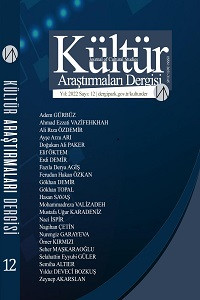Öz
Bu çalışma, kutsal kitapların ve dini metinlerin tercümesindeki temel zorluklardan biri olan dini ifadeler üzerinde yoğunlaşarak, kültürler arası faktörlerin yorumlama üzerindeki etkisini analiz etmeyi hedeflemiştir. Tercümanların bu zor görevin üstesinden gelmek için uyarlama, açıklama ve hariç tutma gibi stratejileri de analiz edilmiştir. Çalışmayı yürütmek için, İran kültüründe siyasi ve kültürel konuşmacılar tarafından kullanılan 50 yaygın kutsal ifade seçilmiştir. İran'da Kültür Devrimi Yüksek Konseyi (SCCR) tarafından yayınlanan bir anket kullanılmıştır. Katılımcılar 30 profesyonel tercümandan oluşmaktadır. Anket 30 profesyonel tercümana dağıtıldıktan sonra, araştırmacılar sözcelerdeki dini ifadelerin yorumlanması için en yaygın stratejileri sınıflandırmışlardır. Çalışma, dini ifadelerin tercümesinde tercümanların önceliğinin %60 oranında uyarlama stratejisi olduğunu göstermiştir. Bu, açıklama ve atlama stratejilerinin siparişlerin sadece %17'sinde ve %23'ünde kullanılmasından kaynaklanmaktadır. Ayrıca dini ifadelerin yorumlanmasının zaman aldığı tespit edilmiş ve bu nedenle ana strateji olarak uyarlama seçilmiştir. Ayrıca, tercümanların mesajı iletmek için en uygun eşdeğeri seçebilmeleri ve tercümeye zaman ayırabilmeleri için hem İran hem de Amerikan kültürleri hakkında iyi bir bilgiye sahip olmaları gerektiği tespit edilmiştir.
Anahtar Kelimeler
Kaynakça
- Ateeg, Najla’a A. & Al-Tamimi, Ibtihal M. (2014). “The Translatability of Emotive Expressions in the Islamic Texts from English into Arabic”. Alandalus Journal of Humanities and Social Sciences, 4(8): 23–51.
- Chaney, Lillian H., & Martin, Jeanette (2007). Intercultural Business Communication. Hoboken, New Jersey: Pearson Prentice Hall.
- Israel, Hephzibah (2019). “Translation and Religion: Crafting Regimes of Identity”. Religion, 49(3): 323–342.
- Khammyseh, Daoud (2015). “The Problems in Translating Islamic Expressions in Religious Occasions”. Journal of Education and Practice, 6(35): 103–109.
- Mehawesh, Mohammad I. & Sadeq Alaeddin (2014). “Islamic Religious Expressions in the Translation of Naguib Mahfouz Novel ‘The Beginning and the End’”. Research on Humanity and Social Sciences, 4(12): 7–18.
- Salehi, Mohammad (2012). “Reflections on Culture, Language and Translation”. Journal of Academic and Applied Studies, 2(5): 128–140.
- Sharma, Vipin (2015). “The Relevance of Addition, Omission and Deletion (AOD) in Translation”. International Journal of Translation, 27(1): 1–12.
Öz
The present study made an effort to analyze the effect of cross-cultural factors on interpretation by concentration on religious expressions as one of the main challenges in translation of holy books and religious texts. Interpreters' strategies such as adaptation, explanation and omission to confront this difficult task were analyzed as well. To conduct the study, researchers selected 50 common holy expressions in Iranian culture which were used by political and cultural speakers in speeches. A questionnaire, released by Supreme Council for Cultural Revolution (SCCR) in Iran, was utilized. The participants were 30 professional interpreters. The questionnaire was distributed among 30 professional interpreters; then the researchers classified the most common strategies for interpretation of religious expressions in utterances. The result demonstrated that adaptation strategy at 60% was interpreters' priority in translation of religious expressions. This originates in the fact that explanation and omission strategies only used in 17% and 23% of orders. Moreover, it was found that religious expressions take time to interpret and that is why adaptation was chosen as the main strategy. In addition, it was found that interpreters are supposed to have perfect knowledge of both Iranian and American cultures to choose the most appropriate equivalent to convey the message and take the time in the interpretation.
Anahtar Kelimeler
interpreter religious expressions culture interpretation utterance
Kaynakça
- Ateeg, Najla’a A. & Al-Tamimi, Ibtihal M. (2014). “The Translatability of Emotive Expressions in the Islamic Texts from English into Arabic”. Alandalus Journal of Humanities and Social Sciences, 4(8): 23–51.
- Chaney, Lillian H., & Martin, Jeanette (2007). Intercultural Business Communication. Hoboken, New Jersey: Pearson Prentice Hall.
- Israel, Hephzibah (2019). “Translation and Religion: Crafting Regimes of Identity”. Religion, 49(3): 323–342.
- Khammyseh, Daoud (2015). “The Problems in Translating Islamic Expressions in Religious Occasions”. Journal of Education and Practice, 6(35): 103–109.
- Mehawesh, Mohammad I. & Sadeq Alaeddin (2014). “Islamic Religious Expressions in the Translation of Naguib Mahfouz Novel ‘The Beginning and the End’”. Research on Humanity and Social Sciences, 4(12): 7–18.
- Salehi, Mohammad (2012). “Reflections on Culture, Language and Translation”. Journal of Academic and Applied Studies, 2(5): 128–140.
- Sharma, Vipin (2015). “The Relevance of Addition, Omission and Deletion (AOD) in Translation”. International Journal of Translation, 27(1): 1–12.
Ayrıntılar
| Birincil Dil | İngilizce |
|---|---|
| Konular | Kültürel çalışmalar |
| Bölüm | Araştırma Makaleleri |
| Yazarlar | |
| Yayımlanma Tarihi | 10 Mart 2022 |
| Yayımlandığı Sayı | Yıl 2022 Sayı: 12 |


